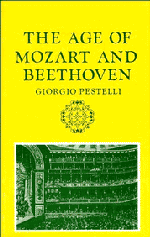III - HAYDN AND MOZART
Published online by Cambridge University Press: 10 November 2010
Summary
Sturm und Drang and music
One of the most radical forms of opposition to the taste for pleasantness, formal refinement and expressive simplicity from which Arcadia, the rococo and the galant style were born was the German literary movement known as Sturm und Drang, which developed between 1770 and 1780, at the same time (but without any similar theoretical element) as many sectors of the musical sphere came to an important turning point.
The movement's name alludes to a play by Friedrich Maximilian Klinger of 1776 entitled Sturm und Drang (Storm and stress). Besides Klinger and other less important figures, Goethe, Herder, Johann Heinrich Merck, Jakob Lenz and Heinrich L. Wagner were all involved in the movement, which also gained more or less lasting sympathy with other young intellectuals and poets like Bürger, the Swiss pastor Lavater, and Schiller. In 1770 none of the members of this group had yet reached the age of thirty; their origins were middle-class and their economic means (except for Goethe's) modest. They were almost all starting off a career as a tutor, entering the service of a prince, or beginning life as a pastor, and they made themselves known through periodicals such as the Frankfurter gelehrte Anzeigen, Thalia and Musenalmanac (the magazine of the Göttingen school of poets). Shakespeare was their guardian spirit, but they found encouragement in contemporary, especially English and French, literature: Rousseau, Richardson, Young's Night thoughts, Warton's The Pleasures of melancholy, Gray's Odes and the heroic and tragic ballads of ancient English poetry published in 1765 by Bishop Thomas Percy.
- Type
- Chapter
- Information
- The Age of Mozart and Beethoven , pp. 101 - 166Publisher: Cambridge University PressPrint publication year: 1984



